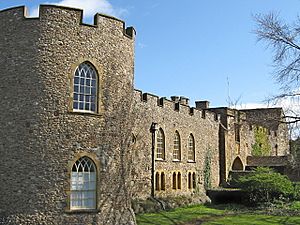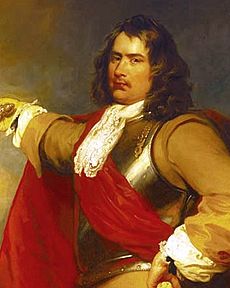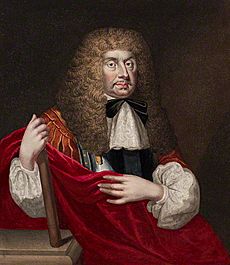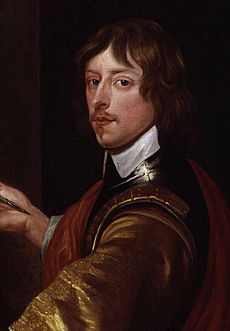Sieges of Taunton facts for kids
Quick facts for kids Sieges of Taunton |
|||||||
|---|---|---|---|---|---|---|---|
| Part of the First English Civil War | |||||||
 Taunton Castle |
|||||||
|
|||||||
| Belligerents | |||||||
| Commanders and leaders | |||||||
| First siege Sir Edmund Wyndham Second siege Sir Richard Grenville, Bt Sir John Berkeley Sir Ralph Hopton Third siege Lord Goring |
Garrison Robert Blake First relief James Holborne Second relief Ralph Weldon Third relief Thomas Fairfax |
||||||
The sieges of Taunton were a series of three blockades that happened during the First English Civil War. The town of Taunton, in Somerset, was very important. It controlled the main road from Bristol to Devon and Cornwall. This made it a key place to hold during the war.
Robert Blake was in charge of Taunton's Parliamentarian defenders. He led the town's defence through all three sieges. These sieges lasted from September 1644 to July 1645.
Contents
What Was the English Civil War?
The First English Civil War was a big fight in England. It happened between 1642 and 1646. It was a struggle for power between King Charles I and the Parliament.
- Royalists: These were people who supported the King. They were also called Cavaliers.
- Parliamentarians: These were people who supported Parliament. They were also called Roundheads.
The war divided families and towns across England.
Why Was Taunton Important?
At the start of the war, people in Somerset were split. Many landowners and country folk supported King Charles I. But most towns, including Taunton, supported Parliament. This was often because of their Puritan beliefs.
In 1642, a small Parliamentarian force held Taunton. In 1643, a Royalist army led by Sir Ralph Hopton took the town without a fight. They set up a garrison (a group of soldiers defending a place) in Taunton Castle.
In mid-1644, the Parliamentarian army wanted to take back the West Country. They moved through Dorset and then towards Chard. The Royalist soldiers in Taunton left the town. Only 80 men stayed to defend the castle.
On July 8, 1644, a Parliamentarian force came to take Taunton back. It was led by Colonel Sir Robert Pye. Robert Blake was his second-in-command. They took the town without a fight. The Royalist soldiers in the castle surrendered. Pye soon left Taunton, leaving Blake in charge. Blake had about 1,000 men. His job was to block roads and help the Parliamentarian army in Devon and Cornwall.
The Sieges
First Siege: September to December 1644

The Parliamentarian army had a big defeat in September 1644. This left only Plymouth, Lyme Regis, and Taunton under Parliamentarian control in the South West. Blake knew Taunton was in danger. Unlike many towns, Taunton did not have strong town walls.
Blake quickly dug trenches and built barricades on the eastern side of town. This was the most open area. He also built at least three earthen forts there. King Charles I ordered a Royalist force of 3,000 troops to begin the first siege of Taunton. Colonel Edmund Wyndham was in command.
The siege started on September 23, 1644. Wyndham was helped by his brother, Francis Wyndham. The Royalists used their cannons to attack the castle and the town. After some early fights, the Royalists broke through the eastern defences. They pushed Blake's troops back into Taunton Castle. The Royalists then set up their blockade about one to two miles away. They focused on starving the defenders rather than constant attacks.
During the siege, Wyndham and Blake wrote letters to each other. Wyndham offered generous terms for surrender. Blake, however, refused the offer completely. Blake sent out small groups of soldiers to fight the attackers. But food and ammunition started to run low for his men. Wyndham also limited food for the town's people. This was to stop them from smuggling food to the soldiers.
Parliament heard about Taunton's struggles. They sent help. Sir William Waller sent 3,000 men under Major General James Holborne. Wyndham had planned to attack Holborne's forces. But instead, he retreated to his garrison at Bridgwater on December 14. He said his enemies were "so hungry that they could not follow me." The next day, a supply caravan arrived. It brought food, 2,000 muskets, and 40 barrels of gunpowder. Holborne also left 1,000 of his own men to help defend Taunton.
Second Siege: March to May 1645
In early 1645, Blake sent out raiding parties from Taunton. These groups controlled a large area and caused problems for the Royalists. Around this time, Lord Goring was a Royalist commander. He wanted to attack Parliamentarian strongholds. He took Weymouth, but could not hold it. The King then ordered him to gather Royalist forces to "clear those parts of the rebels' forces."

The King also ordered Sir Richard Grenville and John Berkeley to help Goring attack Taunton. Goring arrived outside Taunton on March 11. Berkeley's soldiers arrived soon after. Grenville did not come at first. He was busy with another siege. The attack on Taunton was put off.
After more urging from the King, Grenville finally came to Taunton on April 2. He was given command of the siege. But just one day later, Grenville was hurt while attacking Wellington House. He was taken to Exeter because his wound was serious.
Grenville's blockade was far from the town at first. This allowed Blake to send and receive messages. More Royalist soldiers arrived, including Goring's infantry and cannons. The attackers then moved closer to the town. They dug trenches near Taunton's defences. Command of the siege went to Berkeley. But Grenville's soldiers often did not follow Berkeley's orders. Some even left the army. These disagreements led to Sir Ralph Hopton taking command of the siege. He was the Royalist commander in the West Country.
As the siege continued, supplies for the defenders ran low again. Parliament decided that helping Taunton was very important. On April 28, they ordered Thomas Fairfax to relieve the town. Fairfax was the Commander in Chief of the new New Model Army. Fairfax marched his whole army towards Taunton. The Royalists thought about fighting him before he reached London. But they decided to focus on conquering the north of England instead. Fairfax then split his army. He sent 6,000 to 7,000 men to Taunton under Colonel Ralph Weldon. Fairfax led the rest of his army north.
Hopton knew Fairfax's army was coming. He increased his attacks on Taunton on May 6. The next day, attacks focused on the east side of town. They fired cannons and then stormed the earthen fort Blake had built. They captured one fort but were pushed back by musket fire, stones, and boiling water. The next day, Hopton tried to trick Blake. He staged a fake battle to make Blake think the Parliamentarian army had arrived. But the trick failed. That evening, around 7 pm, the Royalist army launched a full attack on the town. They had about 4,200 foot soldiers and 2,000 cavalry.
In heavy fighting, the attackers captured two forts on the eastern side. They broke through the defences. But once inside, they found Parliamentarian soldiers in every house. This stopped them from moving forward. They set fire to buildings, hoping to make the defenders leave. But the wind blew the flames back towards the Royalists. This stopped their attack.
The attack started again around 11 am on May 9. Over the next seven hours, Hopton's army slowly moved through the town. They pushed the Parliamentarian soldiers back building by building. The defenders were left with only a small area in the middle of town. This area included the castle, a trench in the market square, St Mary Magdalene Church, and an earthen defence called "Maiden's fort." Most of the east side of town was on fire from cannons and arson.
More attacks happened on May 10. The Royalists demanded that Blake and his men surrender. Blake famously replied that he "had four pairs of boots left and would eat three of them before he yielded." Weldon's army had met small groups of Royalists. An advance party of Weldon's men reached Orchard Portman, about two miles south of Taunton, on May 10. Hopton thought he was facing all of Fairfax's army. He ordered his forces to stop their attacks and retreat to Bridgwater. As they left, they cut down trees to slow the Parliamentarian advance. Weldon's army arrived in Taunton on May 11. They brought supplies and relieved the town.
Taunton had suffered greatly. Between 50 and 200 people were killed. More than 200 were injured. Two-thirds of the houses in town were burned down. After helping Taunton, Weldon and his army left the next day.
Third Siege: May to July 1645

During the second siege, Lord Goring was with the King. On May 10, he returned to Bristol. He had a royal order making him the Commander of the Royalist Army in the West Country. He replaced Hopton. Goring started by chasing Weldon's army. He forced them to retreat back to Taunton.
Goring, with about 10,000 men, began a third siege of Taunton. This was less than a year after the first one. The King ordered Goring to help the Royalist efforts in the Midlands. But Goring ignored these orders. He claimed that "Taunton would be taken in a few days." But he soon found his army was too small for a quick takeover. He set up a loose blockade. This blockade was not very effective. It even allowed supplies to be carried into the town.
The Parliamentarian commander in the region, Colonel Edward Massey, was ordered to relieve Taunton in June. But he could only gather 3,000 men. This was far too few to defeat Goring's army. Meanwhile, the New Model Army, led by Fairfax, was busy in the Midlands. They were defeating the main Royalist army at the Battle of Naseby. This battle is called "the decisive clash of the English Civil War."
Goring had been ordered by the King to leave his siege and join the Royalist forces at Naseby. Some historians believe that if Goring and his soldiers had been there, the Royalists might have won the battle. Instead, Fairfax won at Naseby. He then led his army towards Taunton again. Goring knew Fairfax's army was coming. He launched a final attack on Taunton on July 9. He hoped to surprise Blake. But a part of Fairfax's army stopped Goring's cavalry near Ilminster. Goring then pulled back from Taunton. He went to meet Fairfax at the Battle of Langport. This ended the third and final siege of Taunton.
What Happened After?
Historians say that over half, or even two-thirds, of Taunton was burned or destroyed during the three sieges. The town and its residents received money to help them rebuild. This money came from fines paid by those who had fought for the Royalists. For example, Sir William Portman was fined £7,000.
After the Civil War, many castles were destroyed by Parliamentarians. But Taunton Castle was seen as a Parliamentarian stronghold. So, it stayed intact. In 1647, the castle was sold. In 1660, after becoming King, Charles II took away Taunton's town charter. This was because of its role in the Civil War. He also had the castle's outer walls removed.
After defending Taunton, Blake was ordered to capture Dunster Castle. He did this after a nine-month siege. After the war, Parliament honored him for his efforts. He received £500, and his men shared £2,000. Blake did not take sides in the Second English Civil War. Three years later, he became a general at sea. He spent the rest of his life as a naval commander. This is what he is best known for today.

